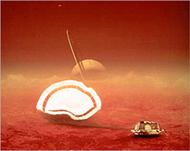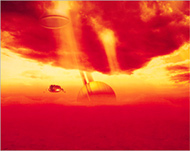Titan probe sends back precious data
A European robot lab parachuted to the surface of the Saturn moon Titan on Friday, successfully climaxing a venture to explore one of the most beguiling phenomena in the solar system.

Operating in the dark and friendless chill of deep space, the unmanned probe Huygens glided to Titan’s surface, relaying its findings to its American mothership Cassini, which then sent the data home to Nasa’s waiting radio sentinels.
Joy erupted at mission control as the precious data poured in.
Scientists and space chiefs have bet more than $3 billion on the Cassini-Huygens project and some have spent a quarter-century of their lives planning it and carrying it out.
The joint mission has been declared “a scientific success”.
Scientists are receiving a stream of data sent back to Earth by the US orbiter Cassini, which was relaying a transmission by the European exploratory probe Huygens, the director-general of the European Space Agency (ESA), Jean-Jacques Dordain, said on Friday.
 |
|
An artist’s impression of |
“Cassini has started delivering data,” Dordain told reporters at mission control in Darmstadt, Germany. “We hope to have the first results tonight.”
Huygens plunged to the surface of Titan earlier on Friday, carrying instruments to assess the moon’s weather system and methane-rich atmosphere during a two-and-a-half-hour parachute glide.
Huygens began its final descent after a seven-year trek covering 2.1 billion km to explore one of the greatest mysteries of the solar system.
It sent out a radio signal, picked up by a listening station on Earth, which was a good sign it had survived the initial buffeting of Titan’s atmosphere.
“The baby is alive,” said a beaming mission manager. Claudio Solazzo, the Huygens mission operations chief, said a heat shield was designed to protect the unmanned craft from the
friction from contact with Titan’s roiling atmosphere.
“The first thing will be the opening of one small parachute. Soon after that, the main parachute, 8m wide, will open. After that, all the instruments will be [turned] on. It will be a clockwork process,” Solazzo said.
‘Similar’ to Earth
For the next two and a half hours, the robot lab was scheduled to film Titan’s surface, measure wind speed and pressure and analyse the atmosphere as it descended to the surface.
 |
|
The Huygens mission was the |
Titan was chosen for the mission because it is the only moon in the solar system that has a substantial atmosphere.
Its thick mix of nitrogen and methane is suspected to be undergoing chemical reactions similar to those that unfolded on Earth billions of years ago.
That process eventually provided the conditions for life on our planet.